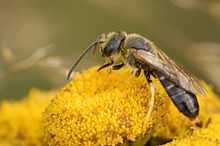Halictus rubicundus
| Halictus rubicundus | |
|---|---|
 | |
| Scientific classification | |
| Kingdom: | Animalia |
| Phylum: | Arthropoda |
| Class: | Insecta |
| Order: | Hymenoptera |
| Family: | Halictidae |
| Genus: | Halictus |
| Species: | H. rubicundus |
| Binomial name | |
| Halictus rubicundus (Christ, 1791) | |
Halictus rubicundus is a species of sweat bee found throughout the Northern Hemisphere. It is small (~1 cm), dark brown, with fine white bands across the apices of the abdominal segments. The legs are often somewhat reddish. The males are more slender, with longer antennae and yellow markings on the face and legs; they are distinguished from males of similar species by the absence of an apical hair band on the terminal abdominal segment.
Its social behaviour differs depending on climate - it is a solitary species in cooler regions, but is eusocial in warmer areas, sometimes with solitary and eusocial colonies appearing simultaneously in the same population.[1]
Nests of H. rubicundus are constructed in the ground. Nests are dug in spring by a single female who typically rears a brood of 5-7 offspring; depending on region, these offspring may be workers, future reproductives, or a mixture of both types. The nest entrance is about 5 mm in diameter and, typically, a small pile of soil (called a "tumulus") accumulates outside the entrance as a result of the female's excavations.
References
- ↑ Yanega, D. (1993) Environmental effects on male production and social structure in Halictus rubicundus (Hymenoptera: Halictidae). Insectes Sociaux 40: 169-180.